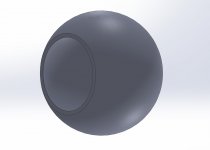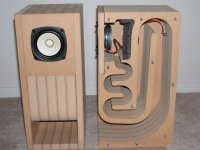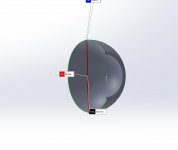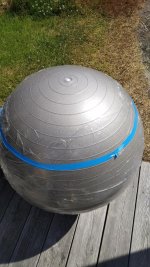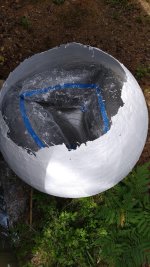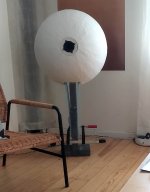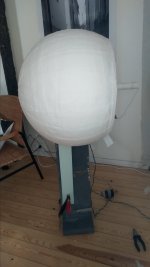Every year I try to do something a little crazy. Last year I built two 15" guitar cabs based on my own design which apparently had a lot in common with the old Forte 3D guitar cabs. They turned out fantastic, so looking to build something crazier now. The 15" cabs turned out great, but there wasn't a lot of trial-n-error. I guess I just happened to guess well on dimensions and such. Looking to be a bit more scientific in this next build.
So what I'm looking to do this year is build another guitar cab. This one would have an 18" driver in a spherical enclosure with a 12" driver in a teardrop shaped enclosure. See attached pic below (not to scale obviously).
Can anyone school me on what I need to know to get the dimensions for this design right?
A few things to note:
The "cone" shaped thing behind the drivers is for rear deflection from the driver. For the 12" cab, this will be screwed into the backside of the cab. For the 15" cab, I will likely need to suspend it inside the cab so it is centered behind the driver. This should add a little bracing and will be closer to the center of the sphere (scale way off on that one).
I was planning to make the walls 1" thick but can be thicker or thinner based on advice here. How thick should the walls be?
I live in South America and wood species are different here. I don't have access to Baltic Birch ply here believe it or not. I used some local pine for my last cabs and it was fine. I will likely veneer these cabs, so I don't care what the wood looks like. But I do need to know what qualities of wood to look for here as any specific wood species suggestion isn't gonna be helpful unless you know how the wood strength/density varies by species here. I know most folks say to look for voidless marine grade wood. Anything else?
My plan is for the 18" cab to be sealed. How can I calculate the cab resonance pre-build to see if I will likely need to add a tuned port?
In my 15" cabs, I spent a bunch of time focused on eliminating standing waves in the cab. Other than the rear cone deflector, I also cut grooves all over the interior of the cab.
For these spherical and teardrop shaped cabs, do I want the inside surfaces to be silky smooth or should I add a bunch of half-dome wood dimples of various sizes inside to create more diffusion?
For the 18" cab, is a sphere going to be better than say slightly stretching the design out into more of an oval?
Any guidance on how to design the curves & proportions of the 12" cab?
For the 12" cab, my idea was to have the piece at the rear with the rear deflector attached have openings to vent from the backside, so this is kinda open back. Any advantage to cutting some slits at the skinny part of the cab to make it even more open or is venting out that backside all I need?

Here was one of the final designs for my 15" cab. I didn't end up doing the rear or side deflectors and used a wood dome rear reflector instead. Design also doesn't show all the details of what I did inside the cab, but you get the idea.
So what I'm looking to do this year is build another guitar cab. This one would have an 18" driver in a spherical enclosure with a 12" driver in a teardrop shaped enclosure. See attached pic below (not to scale obviously).
Can anyone school me on what I need to know to get the dimensions for this design right?
A few things to note:
The "cone" shaped thing behind the drivers is for rear deflection from the driver. For the 12" cab, this will be screwed into the backside of the cab. For the 15" cab, I will likely need to suspend it inside the cab so it is centered behind the driver. This should add a little bracing and will be closer to the center of the sphere (scale way off on that one).
I was planning to make the walls 1" thick but can be thicker or thinner based on advice here. How thick should the walls be?
I live in South America and wood species are different here. I don't have access to Baltic Birch ply here believe it or not. I used some local pine for my last cabs and it was fine. I will likely veneer these cabs, so I don't care what the wood looks like. But I do need to know what qualities of wood to look for here as any specific wood species suggestion isn't gonna be helpful unless you know how the wood strength/density varies by species here. I know most folks say to look for voidless marine grade wood. Anything else?
My plan is for the 18" cab to be sealed. How can I calculate the cab resonance pre-build to see if I will likely need to add a tuned port?
In my 15" cabs, I spent a bunch of time focused on eliminating standing waves in the cab. Other than the rear cone deflector, I also cut grooves all over the interior of the cab.
For these spherical and teardrop shaped cabs, do I want the inside surfaces to be silky smooth or should I add a bunch of half-dome wood dimples of various sizes inside to create more diffusion?
For the 18" cab, is a sphere going to be better than say slightly stretching the design out into more of an oval?
Any guidance on how to design the curves & proportions of the 12" cab?
For the 12" cab, my idea was to have the piece at the rear with the rear deflector attached have openings to vent from the backside, so this is kinda open back. Any advantage to cutting some slits at the skinny part of the cab to make it even more open or is venting out that backside all I need?
Here was one of the final designs for my 15" cab. I didn't end up doing the rear or side deflectors and used a wood dome rear reflector instead. Design also doesn't show all the details of what I did inside the cab, but you get the idea.
Last edited:
I am scratching my head at how you intend to veneer a compound curve.
There are issues with big, laminated layups due to expansion and contraction and humidity.
If you made it out of fiberglass it would be incredibly light but stiff due to the compound curves, light enough you would likely have to add significant mass to keep if from walking.
I don't know of any software that can calculate resonance for that shape, only rectangle and trapezoid shaped rooms. Curious if there are any.
There are issues with big, laminated layups due to expansion and contraction and humidity.
If you made it out of fiberglass it would be incredibly light but stiff due to the compound curves, light enough you would likely have to add significant mass to keep if from walking.
I don't know of any software that can calculate resonance for that shape, only rectangle and trapezoid shaped rooms. Curious if there are any.
That is going to be a gnarly project, so many hurdles to overcome, but that's what makes it fun.
As far as cutting the wood to get a sphere the only way I know to achieve that is to do it in a build up process, like cut your layers from a top down perspective and glue up and layer them together. Then sand down the outer bit to get a smooth finish. See attached image
Wood selection, I think you have Eucalyptus plywood in SA and that is a pretty solid alternative to Baltic birch. A few less layers but its very good still.
I am unaware of any software that would model a specific shape like that, but you could calculate the basic response using a spreadsheet like I do in the video I uploaded yesterday
The excel sheet is in the description and I illustrate how to use it in the video.
Veneering a sphere, I'm not going to say impossible but I have no idea how that would be accomplished
Using those deflection cones without alot of A/B testing to determine there size shape position is probably not advisable, since you cant really model it and test how a 8" cone reacts compared to a 6" cone you really have no idea. So to handle deflection would use something like rockwool/mineral wool on the walls.
I whipped up a quick sphere model and using an 18 inch driver and a sphere is going to be HUGE, in the pictured model the perimeter is 63 inches, diameter is over 30 inches. So just the bottom segment of this thing will be massive... With that said it will be incredible once complete.
As far as cutting the wood to get a sphere the only way I know to achieve that is to do it in a build up process, like cut your layers from a top down perspective and glue up and layer them together. Then sand down the outer bit to get a smooth finish. See attached image
Wood selection, I think you have Eucalyptus plywood in SA and that is a pretty solid alternative to Baltic birch. A few less layers but its very good still.
I am unaware of any software that would model a specific shape like that, but you could calculate the basic response using a spreadsheet like I do in the video I uploaded yesterday
Veneering a sphere, I'm not going to say impossible but I have no idea how that would be accomplished
Using those deflection cones without alot of A/B testing to determine there size shape position is probably not advisable, since you cant really model it and test how a 8" cone reacts compared to a 6" cone you really have no idea. So to handle deflection would use something like rockwool/mineral wool on the walls.
I whipped up a quick sphere model and using an 18 inch driver and a sphere is going to be HUGE, in the pictured model the perimeter is 63 inches, diameter is over 30 inches. So just the bottom segment of this thing will be massive... With that said it will be incredible once complete.
Attachments
I had been planning a couple of years ago to make enclosures of a very similar shape. The best plan - to me - was to cut rings of plywood, stack and glue them together, then make a copy lathe using a router as the cutting head which would follow a template. (Actually an HF spindle, but a router would be fine). Or make friends with a CNC shop if you have the funds. Internal steps/roughness would be academic, and 3/4" thick would be adequate.
a properly designed t line can sound amazing...unfortunately hornresp has a huge learning curve and most are not designed properly so they don't sound great. But they can... Voigt tubes can especially be nice sounding...but I'm not knowledgeable enough to design one correctly. I've tried, never got a freq response in horn resp that I could understand...Usually have to fill like 90% with min wool to get the response curve to do what I want and that is not a viable option.
Note: a good example of how not to do it, these are effectively a joke.
dave
That is not a TL. Certainly not one that is designed.
I am a big fan of TLs & Vigt pipes (they do need to be mass-loaded).
dave
I am a big fan of TLs & Vigt pipes (they do need to be mass-loaded).
dave
I have no idea how that one pictured is designed, I was using it to illustrate the layering process I was trying to describe to the OP. I'm not sure what mass loaded means... They are like magic to me, I don't get it. when playing with horn resp I can move the driver 40% into the line and get a better response, but I have no clue how that is executed in a build. Then to get the response to not be peaky as hell I have to fill the enclosure with mineral wool which in reality kills the Vb so they are far beyond my understanding at this time.That is not a TL. Certainly not one that is designed.
I am a big fan of TLs & Vigt pipes (they do need to be mass-loaded).
dave
Translam… very wasteful for things like what was pictured, and is done like that for looks.
Translam for an unusual shape is a brute force method available to the diyer. Still wasteful and a lot of work, but makes shapes doable.
3D printing will slowly continue to print usual shapes.
dave
Translam for an unusual shape is a brute force method available to the diyer. Still wasteful and a lot of work, but makes shapes doable.
3D printing will slowly continue to print usual shapes.
dave
Yeah, I've since realized that I'm not gonna be able to use veneer, so I will just have them painted to sorta look the way I want them. No biggie.I am scratching my head at how you intend to veneer a compound curve.
There are issues with big, laminated layups due to expansion and contraction and humidity.
If you made it out of fiberglass it would be incredibly light but stiff due to the compound curves, light enough you would likely have to add significant mass to keep if from walking.
I don't know of any software that can calculate resonance for that shape, only rectangle and trapezoid shaped rooms. Curious if there are any.
Thanks for the thoughtful reply! I will check on eucalyptus plywood.That is going to be a gnarly project, so many hurdles to overcome, but that's what makes it fun.
As far as cutting the wood to get a sphere the only way I know to achieve that is to do it in a build up process, like cut your layers from a top down perspective and glue up and layer them together. Then sand down the outer bit to get a smooth finish. See attached image
Wood selection, I think you have Eucalyptus plywood in SA and that is a pretty solid alternative to Baltic birch. A few less layers but its very good still.
I am unaware of any software that would model a specific shape like that, but you could calculate the basic response using a spreadsheet like I do in the video I uploaded yesterdayThe excel sheet is in the description and I illustrate how to use it in the video.
Veneering a sphere, I'm not going to say impossible but I have no idea how that would be accomplished
Using those deflection cones without alot of A/B testing to determine there size shape position is probably not advisable, since you cant really model it and test how a 8" cone reacts compared to a 6" cone you really have no idea. So to handle deflection would use something like rockwool/mineral wool on the walls.
I whipped up a quick sphere model and using an 18 inch driver and a sphere is going to be HUGE, in the pictured model the perimeter is 63 inches, diameter is over 30 inches. So just the bottom segment of this thing will be massive... With that said it will be incredible once complete.
Yes, I'm planning to use the ring method and just cut the shape I need for each. I may have this done via CNC to be more precise and save a bunch of time.
On the deflection cone, I'm planning to make it easy to screw different ones in to try. Top cab probably won't matter as much as I'm planning to have that back end open (except where we screw the cone in). Honestly, I'm just using this to make sure the sound waves don't bounce back directly into the driver. The bigger issue is that I'll need to make sure they are constructed + mounted in a way where they don't vibrate like crazy or resonate at an audible frequency. That might take some experimentation.
I've actually decided to go with two 12 inch drivers instead of the 18". And I'm leaning toward a different shape for the bottom cab. Instead of spherical, it will be more egg-shaped (kinda more like the original iMac G3's.
Here are two pics that give a better idea of my current design thinking. The tube in the bottom might be used as a tuning port but might not be needed. The slots on the bottom cab below the driver are really aesthetic as they kinda match some cabs I built last year and I wanted to tie the aesthetics together.
I wouldn't get too hung up with the 'spike' inside the sub, as you are never really going to be able put anything inside the enclosure of a large enough dimension to materially affect the wavelengths concerned.
One of the advantages of DIY is that you can do crazy stuff that doesn't make a lot of sense just to try it out. I used to live close to the owner or maybe distributor for Shun Mook (http://www.shunmook.com/).I wouldn't get too hung up with the 'spike' inside the sub, as you are never really going to be able put anything inside the enclosure of a large enough dimension to materially affect the wavelengths concerned.
Now, I know most folks think the Shun Mook stuff is the epitome of snake oil, but I hung out at this guy's house for a day and then he came to my place for a day and put a bunch of their Mpingo (African Blackwood, sometimes incorrectly called ebony) disca all over my room. Mpingo is considered the most pleasing musically resonant wood by many. It definitely does something crazy in a good way.
So I've always kinda wanted to experiment with using something like those discs in a speaker build just to see what (if anything) it does. So I'm planning to make the rear-wave deflector out of this wood. I'm also gonna try cutting a bunch of half-spheres in various sizes to make dimples on the interior of the cab.
Again, I know this is over-the-top and some of this stuff will make marginal if any difference, but since I'm doing it myself I can try that stuff for shitz-n-giggles. 🙂
Would you have noticed any difference in a blind test? Expectation bias and persuasive suggestion are powerful things...Now, I know most folks think the Shun Mook stuff is the epitome of snake oil, but I hung out at this guy's house for a day and then he came to my place for a day and put a bunch of their Mpingo (African Blackwood, sometimes incorrectly called ebony) disca all over my room. Mpingo is considered the most pleasing musically resonant wood by many. It definitely does something crazy in a good way.
Given that I started my acoustics life in places like The Royal Festival Hall, The Royal Albert Hall, Westminster Abbey, and Earl's Court in the late '70s, I remain to this day extremely sceptical of acoustical magic; physics, not fashion remains the mainstay in my world. I suggest that 99% of audiophool snake oil products are exactly that and manufactured for a single purpose - to extract money from the gullible and often wilfully ignorant.
By all means play with your imagination and add esoteric features; it is almost certain that they will make your creations sound better to your ears - it's the 'ugly baby' effect, where the parents see nothing but perfect beauty in their offspring.
Start with basic physics though!
Last edited:
I went in highly skeptical and came out slightly less skeptical. It isn't really something you can a/b quickly enough, which is why he wanted me to try them out in my own room for a week. It was an odd thing because depending where he placed the pucks, the soundstage would clearly change. Wasn't even subtle. Tonal changes were impossible to test though as you'd have to remove all the pucks he'd placed in the room to really tell as it's obviously gonna be a subtle thing.Would you have noticed any difference in a blind test? Expectation bias and persuasive suggestion are powerful things...
Given that I started my acoustics life in places like The Royal Festival Hall, The Royal Albert Hall, Westminster Abbey, and Earl's Court in the late '70s, I remain to this day extremely sceptical of acoustical magic; physics, not fashion remains the mainstay in my world. I suggest that 99% of audiophool snake oil products are exactly that and manufactured for a single purpose - to extract money from the gullible and often wilfully ignorant.
By all means play with your imagination and add esoteric features; it is almost certain that they will make your creations sound better to your ears - it's the 'ugly baby' effect, where the parents see nothing but perfect beauty in their offspring.
Start with basic physics though!
I kinda wanna try something similar inside at least the bottom cab just to see if having them inside creates something interesting. Probably not, but I can use scraps for most of this other than the rear deflector.
I fiber glassed a 100cm exercise ball for some Halloween decorations, they are crazy strong and ridicously light. I had to screw on weights to keep them from blowing away.
If you want the look of wood on a sphere, I wonder how well hydro dipping would work for a wood grain look.
I built these around a exercise ball using plaster. They are thin because that are a baffle not an pressurised enclosure.
//
//
Attachments
I did the exercise ball enclosure thing with fiberglass and resin. You must wrap the ball in plastic shrink wrap before hand to keep the fiberglass resin from sticking and attacking the ball. A gel coat will help alot here and give you a nice clean finish inside the sphere. Also make sure the ball's air valve is accessible via a small 4-5 " opening left uncovered. You could of course also use epoxy resin instead which is safe for the ball and also has less odor, but you'll need some form of mold release ie. cured PVA or white wood glue. Once you have a few layers thickness of fiberglass, deflate and remove the ball from inside through the small opening, then enlarge the hole to accept a mounting flange for your driver. Finally add a few more fiberglass layers until you end up with about 1/4 to 3/8 inch thickness depending on overall diameter of sphere.
A spherical enclosure requires special dampening strategies to avoid strong resonant standing wave modes from occurring, as you will encounter completely identical wall to wall distances inside being its sphere shaped. A larger balled up variably density bunch of dampening materials is best for this suspended in the center of the sphere a few inches away from the driver rear surface, as well as some heavier density dampening lining the inner walls.
A spherical enclosure requires special dampening strategies to avoid strong resonant standing wave modes from occurring, as you will encounter completely identical wall to wall distances inside being its sphere shaped. A larger balled up variably density bunch of dampening materials is best for this suspended in the center of the sphere a few inches away from the driver rear surface, as well as some heavier density dampening lining the inner walls.
- Home
- Design & Build
- Construction Tips
- Advice for teardrop and spherical speaker cab build
